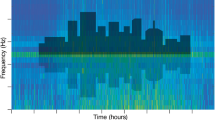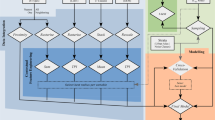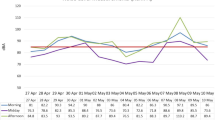Abstract
Environmental epidemiological studies rely on the quantification of the exposure level in a surface defined as the subject’s exposure area. For residential exposure, this area is often the subject’s neighborhood. However, the variability of the size and nature of the neighborhoods makes comparison of the findings across studies difficult. This article examines the impact of the neighborhood’s definition on environmental noise exposure levels obtained from four commonly used sampling techniques: address point, façade, buffers, and official zoning. A high-definition noise model, built on a middle-sized French city, has been used to estimate LAeq,24 h exposure in the vicinity of 10,825 residential buildings. Twelve noise exposure indicators have been used to assess inhabitants’ exposure. Influence of urban environmental factors was analyzed using multilevel modeling. When the sampled area increases, the average exposure increases (+3.9 dB), whereas the SD decreases (−1.6 dB) (P<0.01). Most of the indicators differ statistically. When comparing indicators from the 50-m and 400-m radius buffers, the assigned LAeq,24 h level varies across buildings from –9.4 to +22.3 dB. This variation is influenced by urban environmental characteristics (P<0.01). On the basis of this study’s findings, sampling technique, neighborhood size, and environmental composition should be carefully considered in further exposure studies.
This is a preview of subscription content, access via your institution
Access options
Subscribe to this journal
Receive 6 print issues and online access
$259.00 per year
only $43.17 per issue
Buy this article
- Purchase on Springer Link
- Instant access to full article PDF
Prices may be subject to local taxes which are calculated during checkout






Similar content being viewed by others
References
Committee on Environmental Health. Noise: a hazard for the fetus and newborn. Pediatrics 1997; 100: 724–727.
Stansfeld SA, Clark C, Cameron RM, Alfred T, Head J, Haines MM et al. Aircraft and road traffic noise exposure and children’s mental health. J Environ Psychol 2009; 29: 203–207.
Van Kempen EE, Kruize H, Boshuizen HC, Ameling CB, Staatsen BA, de Hollander AE . The association between noise exposure and blood pressure and ischemic heart disease: a meta-analysis. Environ Health Perspect 2002; 110: 307–317.
Babisch W, Beule B, Schust M, Kersten N, Ising H . Traffic noise and risk of myocardial infarction. Epidemiology 2005; 16: 33–40.
De Kluizenaar Y, Gansevoort RT, Miedema HME, de Jong PE . Hypertension and road traffic noise exposure. J Occup Environ Med 2007; 49: 484–492.
Klepeis NE, Nelson WC, Ott WR, Robinson JP, Tsang AM, Switzer P et al. The National Activity Pattern Survey (NHAPS): a ressource for assessing exposure to environmental pollutants. J Expo Anal Environ Epidemiol 2001; 11: 231–252.
European Commission. How Europeans spend their time. Everyday life of women and men 2004.
Murphy E, King EA, Rice HJ . Estimating human exposure to transport noise in central Dublin, Ireland. Environ Int 2009; 35: 298–302.
Selander J, Nilsson ME, Bluhm G, Rosenlund M, Lindqvist M, Nise G et al. Long-term exposure to road traffic noise and myocardial infarction. Epidemiology 2009; 20: 272–279.
Beelen R, Hoek G, Pebesma E, Vienneau D, de Hoogh K, Briggs DJ et al. Mapping of background air pollution at a fine spatial scale across the European Union. Sci Total Environ 2009; 407: 1852–1867.
Bodin T, Albin M, Ardö J, Stroh E, Ostergren PO, Björk J et al. Road traffic noise and hypertension: results from a cross-sectional public health survey in southern Sweden. Environ Health 2009; 8: 38.
Ising H, Lange-Asschenfeldt H, Moriske H-J, Born J, Eilts M . Low frequency noise and stress: bronchitis and cortisol in children exposed chronically to traffic noise and exhaust fumes. Noise Health 2004; 6: 21–28.
Gan WQ, McLean K, Brauer M, Chiarello SA, Davies HW . Modeling population exposure to community noise and air pollution in a large metropolitan area. Environ Res 2012; 116: 11–16.
Havard S, Reich BJ, Bean K, Chaix B . Social inequalities in residential exposure to road traffic noise: an environmental justice analysis based on the RECORD Cohort Study. Occup Environ Med 2011; 68: 366–374.
National Institute of the Statistics and the Economic Studies. Populations légales 2008 de Besançon 2008. <http://www.insee.fr/fr/ppp/bases-de-donnees/recensement/populations-legales/commune.asp?annee=2008&depcom=25056>.
National Institute of the Statistics and the Economic Studies. Urban units of more than 100,000 inhabitants in 2009 2010. <http://www.insee.fr/en/themes/tableau.asp?reg_id=0&ref_id=nattef01204>.
Pujol S, Houot H, Antoni JP, Mauny F Linking traffic and noise models to explore spatio-temporal distribution of noise pollution: an example in Besançon (France). In: Proceedings of the 19th International Congress on Sound and Vibration. Vilnius (Lituania), 2012.
Houthuijs D, Stansfeld S, Babisch W, Berry B, Botteldooren D, Floud S et alWP3 - Noise Exposure Assessment. European Network on Noise and Health, 2010.
Pujol S, Berthillier M, Defrance J, Lardiès J, Petit R, Houot H et al. Urban ambient outdoor and indoor noise exposure at home: a population-based study on schoolchildren. Appl Acoust 2012; 73: 741–750.
National Institute of the Statistics and the Economic Studies. Definition of ‘Statistical Block’ 2013. <http://www.insee.fr/en/methodes/default.asp?page=definitions/ilot.htm>.
National Institute of the Statistics and the Economic Studies. Definition of ‘IRIS’ 2013. <http://www.insee.fr/en/methodes/default.asp?page=definitions/iris.htm>.
Houot H . Geographical approach of annoyance due to noise transportation. In:. Proceedings of Internoise 2000, vol. 4, Nice (France), 2000.
National Institute of the Statistics and the Economic Studies. Results of the Population Census - 2009 2009 <http://www.recensement.insee.fr/basesInfracommunales.action>.
Murphy E, King EA . Strategic environmental noise mapping: methodological issues concerning the implementation of the EU Environmental Noise Directive and their policy implications. Environ Int 2010; 36: 290–298.
Nieuwenhuijsen M, Paustenbach D, Duarte-Davidson R . New developments in exposure assessment: the impact on the practice of health risk assessment and epidemiological studies. Environ Int 2006; 32: 996–1009.
Smith G, Gidlow C, Davey R, Foster C . What is my walking neighbourhood? A pilot study of English adults’ definitions of their local walking neighbourhoods. Int J Behav Nutr Phys Act 2010; 7: 34–42.
Forsyth A, Hearts M, Oakes J, Schmitz K . Design and destinations: factors influencing walking and total physical activity. Urban Stud 2008; 45: 1973–1996.
Cayo MR, Talbot TO . Positional error in automated geocoding of residential addresses. Int J Health Geogr 2003; 2: 10.
Bonner MR, Han D, Nie J, Rogerson P, Vena JE, Freudenheim JL . Positional accuracy of geocoded addresses in epidemiologic research. Epidemiology 2003; 14: 408–412.
Eriksson C, Nilsson ME, Stenkvist D, Bellander T, Goran P . Residential traffic noise exposure assessment: application and evaluation of European Environmental Noise Directive maps. J Expo Sci Environ Epidemiol 2012; 23: 531–538.
ISO 1996-2:2007. Acoustics. Description, assessment and measurement of environmental noise - Part 2: Determination of environmental noise levels. Int Organ Stand 2006.
WHO Europe Night Noise Guidelines for Europe. World Health Organization - Regional Office for Europe, 2009.
Pirrera S, Valck ED, Cluydts R . Nocturnal road traffic noise assessment and sleep research: the usefulness of different timeframes and in- and outdoor noise measurements. Appl Acoust 2011; 72: 677–683.
Galster G . On the nature of neighbourhood. Urban Stud 2001; 38: 2111–2124.
Chaix B, Merlo J, Evans D, Leal C, Havard S . Neighbourhoods in eco-epidemiologic research: delimiting personal exposure areas. A response to Riva, Gauvin, Apparicio and Brodeur. Soc Sci Med 2009; 69: 1306–1310.
Scott MM, Evenson KR, Cohen DA, Cox CE . Comparing perceived and objectively measured access to recreational facilities as predictors of physical activity in adolescent girls. J Urban Health 2007; 84: 346–359.
Prins R, Oenema A, van der Horst K, Brug J . Objective and perceived availability of physical activity opportunities: differences in associations with physical activity behavior among urban adolescents. Int J Behav Nutr Phys Act 2009; 6: 70.
Montalvào Guedes IC, Bertoli SR, Zannin PH . Influence of urban shapes on environmental noise: a case study in Aracaju - Brazil. Sci Total Environ 2011; 412-413: 66–76.
Wang B, Kang J . Effects of urban morphology on the traffic noise distribution through noise mapping: a comparative study between UK and China. Appl Acoust 2011; 72: 556–568.
Pujol S, Levain JP, Houot H, Petit R, Berthillier M, Defrance J et al. Association between Ambient Noise Exposure and School Performance of Children Living in An Urban Area: A Cross-Sectional Population-Based Study. J Urban Health 2013, 1–16.
Wang Z, Lee C . Site and neighborhood environments for walking among older adults. Health Place 2010; 16: 1268–1279.
Parra DC, Gomez LF, Fleischer NL, David Pinzon J . Built environment characteristics and perceived active park use among older adults: results from a multilevel study in Bogota. Health Place 2010; 16: 1174–1181.
Hohmann C, Grabenhenrich L, de Kluizenaar Y, Tischer C, Heinrich J, Chen CM et al. Health effects of chronic noise exposure in pregnancy and childhood: a systematic review initiated by \ENRIECO\. Int J Hyg Environ Health 2013; 216: 217–229.
Klepeis NE, Tsang AM, Behar JV Analysis of the National Human Activity Pattern Survey (NHAPS) Respondents from a Standpoint of Exposure Assessment. US Environmental Protection Agency: Las Vegas (NV),. 1995.
National Institute of the Statistics and the Economic Studies. Depuis 11 ans, moins de tâches ménagères, plus d’Internet. INSEE Prem. 4, 2011.
Acknowledgements
Quentin Tenailleau is a Ph.D student supported by a grant from the city of Besançon. We would like to thank the city services, the urban community of Besançon (CAGB), the Besançon Urban Development Agency (AUDAB), and the Departmental Public Works Directorate (DDE) for their technical support.
Author information
Authors and Affiliations
Corresponding author
Ethics declarations
Competing interests
The authors declare no conflict of interest.
Rights and permissions
About this article
Cite this article
Tenailleau, Q., Bernard, N., Pujol, S. et al. Assessing residential exposure to urban noise using environmental models: does the size of the local living neighborhood matter?. J Expo Sci Environ Epidemiol 25, 89–96 (2015). https://doi.org/10.1038/jes.2014.33
Received:
Revised:
Accepted:
Published:
Issue Date:
DOI: https://doi.org/10.1038/jes.2014.33
Keywords
This article is cited by
-
Association between moderated level of air pollution and fetal growth: the potential role of noise exposure
Scientific Reports (2021)
-
User-specific and Dynamic Internalization of Road Traffic Noise Exposures
Networks and Spatial Economics (2017)
-
Residential and GPS-Defined Activity Space Neighborhood Noise Complaints, Body Mass Index and Blood Pressure Among Low-Income Housing Residents in New York City
Journal of Community Health (2017)
-
Intermittency ratio: A metric reflecting short-term temporal variations of transportation noise exposure
Journal of Exposure Science & Environmental Epidemiology (2016)



